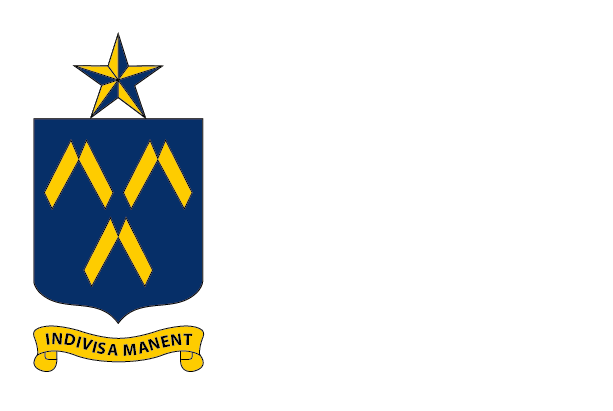Link: https://bit.ly/43dVHFx
From: Emea Tribun
Dheisheh camp – In the Dheisheh camp in the city of Bethlehem, south of Jerusalem, the visual artist Shatha Safi lives in the “temporary station”, which she insists on leaving one day to return to her village of Jerusalem, which was depopulated in 1948, “Jarash”.
Four decades after the Nakba, Safi was born in Jordan to a struggling father and a mother from the same village. The year 1996 marked the difference in her life when she visited her maternal grandmother’s house in Dheisheh camp for the first time.
There, she listened to the stories of the catastrophe that flowed through her grandmother, Ghazlan, whose children were divided between a prisoner and a pursuer, and she played with the children of her peers in the alleys of the camp what she had never played in her childhood outside Palestine, such as “Arabs and Jews” and “There was a war between us and them,” and it focuses on hit-and-run operations Between the people of the camp and the Israeli occupation army.
Shatha Safi learned art herself, drawing her inspiration from history, heritage, the Palestinian resistance and the Nakba, which she did not experience but lived through and appeared in her artwork.
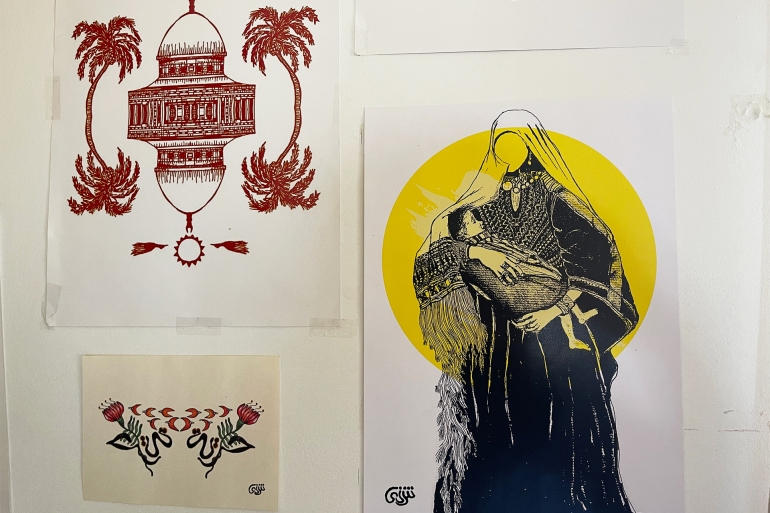
Nakba on every corner
In her home – in which the Nakba and the issue of asylum appear in every corner and on its walls – she received Safi Al-Jazeera Net, and talked about her father’s discovery of her talent when she completed her first drawings of the leader “Abu Jihad” (the leader in the Palestinian National Liberation Movement (Fatah), the martyr Khalil Al-Wazir), and then it rolled Drawings in which the features of the Nakba, its pain, and the hopes of the refugees who suffered from its fire became clearer.
She says, “My father saw the light in 1945 in the village of Jerash, and he settled in the Dheisheh camp, and there he lived a difficult childhood that he always told me about; he talked about extreme poverty and the children’s torn clothes that did not protect them from the harsh winter cold, and he told me that lentil soup was the daily meal of the camp children. It is distributed to them in the Agency’s schools” (UNRWA).
Safi expresses her gratitude that her father decided to return to Dheisheh camp in 2004 permanently after a long expatriation journey in which he toured as a student and employee in Germany, Lebanon, Tunisia and Jordan, and despite the harshness of living in refugee camps, Safi feels safe in this crowded geographical area with about 13 thousand refugees live in the camp and only dream of returning to their abandoned villages.
Her artistic career has evolved and is no longer limited to drawing. In 2016, she entered the world of forming clay sculptures to reproduce familiar forms of Palestinian dress, in an attempt to preserve memory.
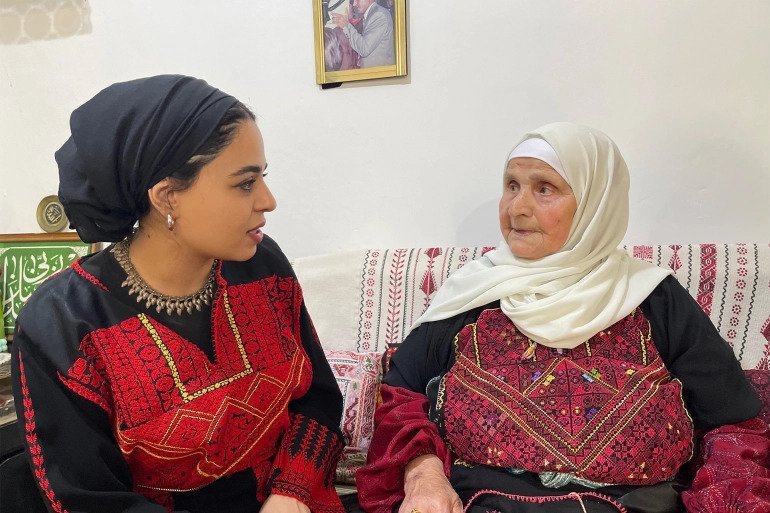
The daughter of the sun
Shatha Safi named her collection made of clay “The Daughter of the Sun,” and said, “The clay represents my land, my home, my abandoned village, and the olive tree that my grandmother used to shelter in for years while she was spinning and embroidering her dress. The sun that dried the figures expresses our freedom, our hope, our strength, and our dream of return.”
The dresses of her grandmothers, Ghazlan and Khairiya, and her mother, Adla, were the source of inspiration for her clay works, and from there she set out to explore the dresses of the elderly women of the camp who were displaced from the same village and the neighboring villages.
In the alleys of the camp, we accompanied her to the house of Hajja Khadra, who hails from the same village, and there we listened to a passionate conversation led by the ninety-year-old who came out of Jerash carrying 12 traditional clothes that she sewed for herself with her own hands.
“This, my lady, is the sweat of the deer, and this is the sweat of the sugar cane, and that is the sweat of the roses, and that horn and sickles,” Khadra explains at length the details of her dresses, and Safi listens carefully and asks about this and that dress, and about the dozens of pieces of “peasant embroidery” that are scattered in the grandmother’s house.
In other photos and many sources as well, Shatha Safi searched for the grandmothers’ heritage and the reasons for the emergence of this or that “stitch” in the various Palestinian cities and villages, until she made hundreds of clay dresses.
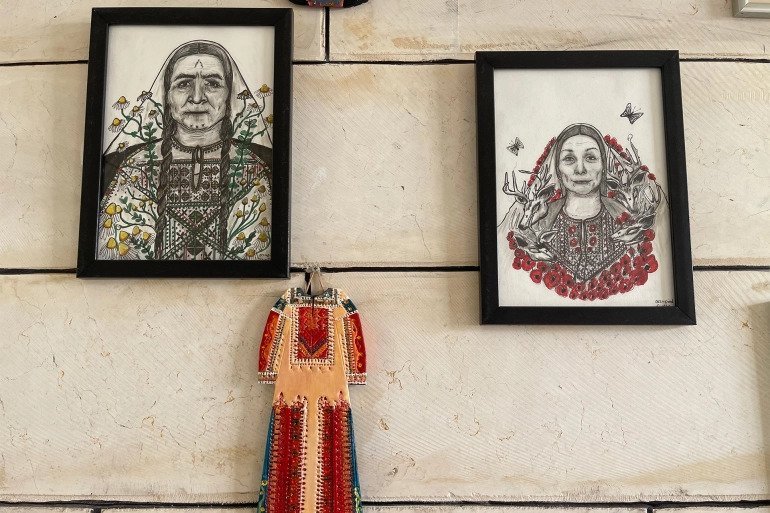
Nakba live in it
On the seats of Bethlehem University, Shatha Safi studied social work, and the refugees had the largest share of her educational career. She prepared her graduation project under the title “After the Trauma of Refugeehood in the Dheisheh and Shatila Camps”.
This young woman hopes that one day she will be freed from the office job to devote herself entirely to the art that she has devoted to serving her cause and her story, which is similar to the stories of millions of refugees around the world.
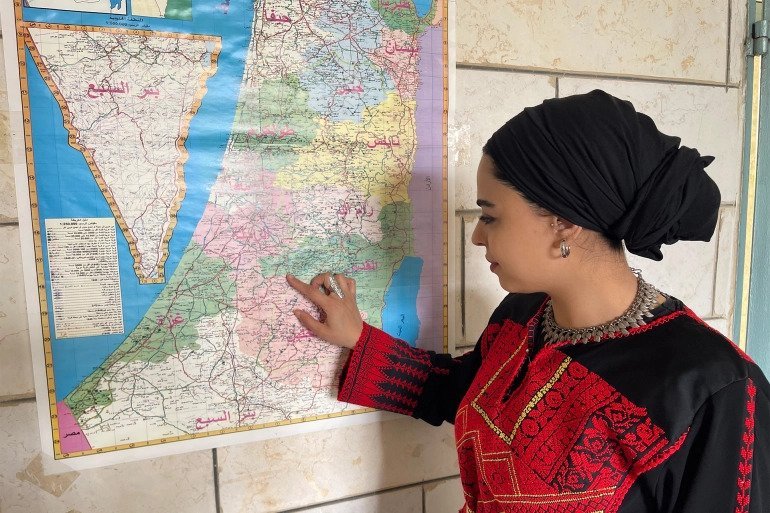
During the exit from the camp, a mixture of smells emanating from the kitchens of adjoining houses sneaks into the visitor’s nose. It has the village of Jerash, which today is covered with weeds creeping into the remains of destroyed houses, in addition to the steadfastness of a number of carob, fig, and olive trees.

